PA - Final
CS149: Introduction to Programming
James Madison University - Fall 2020 Semester

Final Programming Assignment
WordTangle
1. Due Dates and Submission Details
See below for all due dates and submission details. Note there are multiple submission parts. Downloads
2. Honor Code
This assignment should be completed individually to maximize learning. It is important that you adhere to the Course Policies.
3. Learning Objectives
This programming assignment is designed to help you learn about (and assess whether you have learned about):
-
Creating classes of immutable objects.
-
Creating classes of mutable objects.
-
Creating and using objects (and classes).
-
The difference between (and appropriate use of) static and non-static methods and attributes.
-
The difference between the owning object of a method and the objects that are passed as parameters to a
method (e.g., the difference between the String object s and the String object t in the expression s.equals(t)). -
A basic understanding of the reference null.
It is also intended to reinforce what you have already learned about conditions and decisions, loops, arrays, unit testing, and various programming patterns.
4. Background
WordTangle is a word game in which the player tries to find a specific word in a rectangular grid of tiles. The player is given a hint and the starting letter. The player must build the word by selecting letters that are to the north, south, east, or west of the previous letter in the word. For example, in the following grid the player was given the 'T' as the starting letter and the hint “Twist together into a confused mass”.
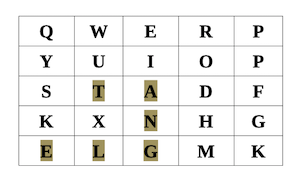
The player found the correct answer, “TANGLE” by selecting the letter to the east of the 'T', to the south of the 'A', to the south of the 'N', to the west of the 'G', and to the west of the 'L'.
4.1 Game Play
A game of WordTangle consists of multiple rounds. At the start of the game, the player is presented with a rectangular grid of tiles, each of which contains a letter. The size of the rectangle can vary, the same letter may appear on multiple tiles, and some letters may be omitted.
At the start of each round, the player is given a hint, the first tile in the word, and the number of letters/tiles in the word. The player must then select the next letter in the word, which must be to the north, south, east, or west of the first letter. The player must continue in this fashion, moving to the north, south, east or west of the last selected tile, until all of the letters in the word have been selected.
The player is not given any feedback after selecting a tile. Feedback is only given after all of the tiles are selected.
At any point, the player can “undo” the last selected letter. However, there may be limits placed on the number of times each letter (not tile) can be “undone”. If there is such a limit, it applies to the entire game (not individual rounds).
4.2 Graphical User Interface
The graphical user interface (GUI) for this implementation of WordTangle has already been created and looks something like the following:
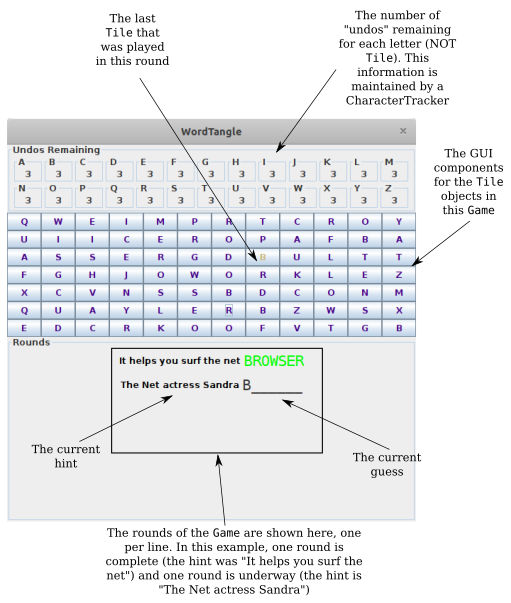
The user selects a tile by clicking on it, which: (1) changes its color from purple to gold, and (2) adds the letter to the current guess (which is displayed to the right of the hint).
The user can “undo” the last tile selected by clicking on it. This will change its color back to purple and remove it from the word after the hint. It will also reduce the number of remaining “undos” for that letter (unless the player has infinite/unlimited “undos”).
When the player’s guess is as long as the answer, the word after the hint will turn either green (if it is correct) or red (if it is not). If the guess is correct, the next round will be started. If it isn’t the player must “undo” tiles and try again. If the player runs out of “undos” for any letter, the game is over.
5. System Design
The overall design of the system is illustrated in the following UML class diagram. In this diagram, the classes that are drawn in blue have already been implemented and the classes that are drawn in black must be implemented by you.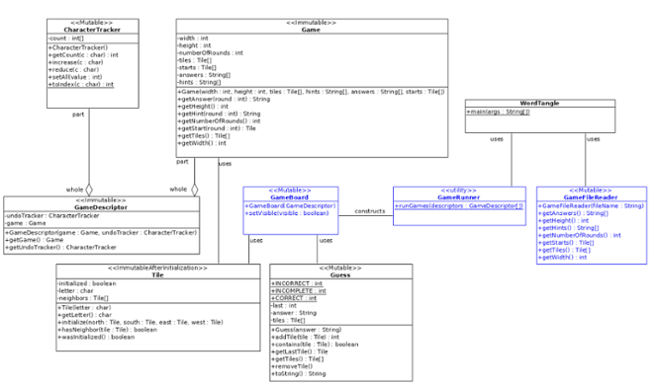
6. Description of Existing Classes
This section contains information over and above the information that is contained in the UML class diagram.
6.1 The GameFileReader Class
As the name implies, a GameFileReader object can be used to read a single file containing all of the information that describes an individual Game. The information will be read when the object is constructed. The various accessors can then be used to obtain all of the attributes of the Game.
The following attributes are the same for all rounds of the Game:
• The Tile array (containing all of the Tile objects in the rectangular grid);
• The width of the rectangular grid; and
• The height of the rectangular grid.
The following attributes are different for each round:
• The correct answer;
• The hint; and
• The starting Tile.
These attributes are stored in conformal arrays in which the index corresponds to the round number. So, the size of these arrays corresponds to the number of rounds.
6.2 The GameRunner Class
The GameRunner class is a utility class that contains a single method, runGames(). It is passed an array of GameDescriptor objects (discussed below) that is required to play a particular Game.
6.3 The GameBoard Class
The GameBoard class is an encapsulation of the graphical user interface and the game-play logic. You will not need to use this class at all, it is used by the GameRunner class.
7. Description of Classes that Need to be Written
You must write and test several classes for the assignment. If a specification states that a class must have a particular method then that method must be public. Classes may contain methods and attributes that are not included in the specifications. All attributes must be private except for the “constants” in the Guess class.
In this section, the classes are presented in an order that makes sense conceptually. The order in which you should probably implement them is discussed later.
Note that, though you must implement and test all of the methods in all of these classes, you may not need to use all of them in the other classes that you write. Some of them may be used by the existing classes.
7.1 The Tile Class
The Tile class is an encapsulation of a single tile in the rectangular grid of tiles. The attributes of a Tile include its letter and its north, south, east and west neighbors in the rectangular grid, each of which is, itself, a (reference of) a Tile object. This can be visualized for a single Tile object as follows: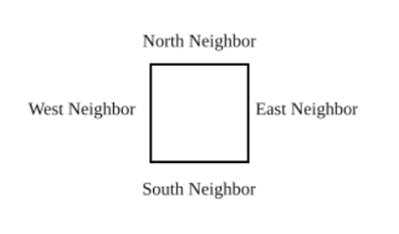
When a Tile is constructed, the constructor will only be passed its letter. Its neighbors can only be initialized (by calling its initialize() method) after all of the Tile objects in the grid have been constructed. So, objects in the Tile class are described as “immutable after initialization”. This is formalized in the following specification:
S7.1.1 The first time the initialize() method is called, the elements of the neighbors array must be initialized appropriately and the value of the initialized attribute must be set appropriately. Subsequent calls to the initialize() method must not change these attributes.
In addition, to this specification and the other specifications contained in the UML class diagram, your implementation must comply with the following specification:
S7.1.2 The hasNeighbor() method must return true if the parameter named tile is either the north, south, east or west neighbor of the owning Tile, and must return false otherwise.
S7.1.3 The wasInitialized() method must return true if the method named initialize() has been invoked and must return false otherwise.
7.2 The Game Class
The Game class is an encapsulation of the attributes of a single game. Game objects must be immutable. That is, the attributes must not change after the object is constructed.
Note that all of the attributes needed to construct a Game object can be obtained from a GameFileReader.
In addition to the specifications that are contained in the UML class diagram, your implementation must comply
with the following specifications.
S7.2.1 The getAnswer() method must return null if the parameter named round is out of range.
S7.2.2 The getHint() method must return null if the parameter named round is out of range.
S7.2.3 The getStart() method must return null if the parameter named round is out of range.
S7.2.4 The getStart() method must return the (reference to) the appropriate element of the starts array that is passed to the constructor, not a copy or clone.
S7.2.5 The getTiles() method must return the (reference to) the tiles array that is passed to the constructor, not a copy or clone.
- 7.3 The Guess Class
The Guess class is an encapsulation of all of the Tile objects in the player’s guess. When a Guess object is constructed, it is passed the correct answer. Guess objects are mutable.
As the player adds a Tile to the Guess, the addTile() method is called. When the player “undoes” a Tile, the removeTile() method is called. Both of these methods modify the last non-null element of the array named tiles (if there is one) and the attribute named last. How they do so is up to you.
In addition to the specifications that are contained in the UML class diagram, your implementation must comply with the following specifications:
S7.3.1 The tiles array must have exactly as many elements as number of characters in the answer attribute and “empty” elements must be null.
S7.3.2 The addTile() method must not add a Tile that is already an element of the tiles array.
S7.3.3 The addTile() method must not add a Tile if the tiles array is full.
S7.3.4 The addTile() method must not add a Tile if the tile to be added is not a neighbor of the last
non-empty element of the tiles array.
S7.3.5 The addTile() method must return Guess.INCOMPLETE if the number of non-null elements of the tiles array is less than the length of the answer attribute. Otherwise, it must return either Guess.CORRECT or Guess.INCORRECT as appropriate. This must be the case regardless of whether the Tile was added or not.
S7.3.6 The contains() method must return true if the tiles array contains the parameter named tile and must return false otherwise.
S7.3.7 The getLastTile() method must return the last non-null Tile.
S7.3.8 The getTiles() method must return all of the Tile objects (both null and non-null), in the
correct order.
S7.3.9 The toString() method must return a String that has the same length as the answer attribute. It must contain the characters associated with the non-null elements of the tiles array (in the appropriate order) followed by as many underscore characters (i.e., '_' characters) as there are null elements in the tiles array. (See the “Hints” section below for a hint on how to implement this method.)
7.4 The CharacterTracker Class
The CharacterTracker class is not specific to WordTangle; a CharacterTracker object can be used to keep count of the number of times a particular (upper-case) character has been “used” in a variety of different applications. CharacterTracker objects are mutable.
Because there are 26 different (upper-case) characters in the English alphabet, an accumulator array is used (rather than 26 different attributes). This array is named count. Each element of count contains the number of times a particular (upper-case) character has been “used”. Note that this number can be negative if the
decrease() method is called more times that the increase() method.
In addition to the specifications that are contained in the UML class diagram, your implementation must comply
with the following specifications:
S7.4.1 The count array must be 0-based and have exactly 26 elements (one for each upper-case letter in the English alphabet).
S7.4.2 The elements in the count array must be in alphabetical order (i.e., 'A' in element 0, 'B' in element 1, ..., 'Z' in element 25.
S7.4.3 The getCount() method must return the element of the count array that corresponds to the character c.
S7.4.4 The increase() method must increase the element of the count array that corresponds to the character c by 1.
S7.4.5 The reduce() method must reduce the element of the count array that corresponds to the character c by 1.
S7.4.6 The setAll() method must set all elements of the count to the given value.
S7.4.7 The static toIndex() method must return the index that corresponds to the character c. The value
returned must be in the interval [0, 25]. (See the “Hints” section below for a hint on how to implement this method.)
In the context of WordTangle, a CharacterTracker object is used to keep track of the number of “undos” remaining for each letter.
7.5 The GameDescriptor Class
A GameDescriptor object contains a Game object and a CharacterTracker object. In other words, it contains all of the information needed by the GameRunner class to start a game.
The Game and CharacterTracker are kept separate so that the same Game can be played with different “undo” rules.
GameDescriptor objects are immutable.
7.6 The WordTangle Class
The WordTangle class is the main class for the application. That is, it contains the entry-point for the application.
The main() method will be passed a segmented array in which each record contains two fields, the name of a file containing information about a game and the number of “undos” (which is assumed to be the same for all letters). So, for example, the application might be executed as follows:
java WordTangle net.txt 3 cs.txt -1
It must then use this information to construct a GameDescriptor array that has two elements. For element 0 of the array:
• The Game must be constructed using a GameFileReader that reads the file net.txt;and
• The CharacterTracker must have all of its elements initialized to 3.
For element 1 of the array:
• The Game must be constructed using a GameFileReader that reads the file cs.txt and
• The CharacterTracker must have all of its elements initialized to -1(which will be used to indicate that the number of “undos” is infinite).
Obviously, after the GameFileReader is constructed, you will need to call its various accessors to get the
information you need to construct the Game object.
In addition to the specifications that are implicit in the discussion above and the UML class diagram, this class
must comply with the following specifications:
S7.6.1 The main() method must work with any number of records (i.e., with any even number of command line arguments). It need not validate the command line arguments.
S7.6.2 After constructing the array of GameDesciptor objects, the main() method must call the runGames()
method in the GameRunner class.
8. A Recommended Process
This assignment is complicated enough that you are unlikely to complete it if you do not use a good process. What follows is one such process. It includes an effort estimate (shown in brackets) for each of the major tasks. This is an estimate of how long it should take a CS149 student to complete the task (assuming you already understand the material being covered), not how long it will take you or how much time you should budget. You must determine how well you understand the material and be able to roughly predict how long it will take you to complete a particular task.
1. Read and understand the product description and specifications (and complete submission A). [1.00 hour]
2. Create a directory/folder for this assignment. [0.05 hours]
3. Download ExistingClasses.zip and unzip it in the directory/folder for this assignment. [0.05 hours]
For instructions on adding these to Eclipse see the CS Wiki
4. Download DataFiles.zip and unzip it in the directory/folder for this assignment. [0.05 hours]
5. Download Stubs.zip and unzip it into the directory/folder for this assignment. This file contains stubbed-out versions of all of the classes (i.e., initial encapsulations of all of the classes that contain the public “constants” and public methods with empty bodies, except for return statements where needed. [0.05 hours]
6. Complete the GameDescriptor class. [0.25 hours]
6.1. Write the constructor, getGame() and getUndoTracker() methods.
6.2. Test (and debug, if necessary) these methods.
7. Complete the Tile class. [0.75 hours]
7.1. Write the constructor and getLetter() method.
7.2. Test (and debug, if necesssary) these methods.
7.3. Write the initialize() and wasInitialized() methods.
7.4. Test (and debug, if necesssary) these methods.
8. Complete the Game class. [1.00 hour]- 8.1. Write the constructor, getHeight(), getWidth(), getNumberOfRounds() and
getTiles() methods.
8.2. Test (and debug, if necessary) these methods.
8.3. Implement the getAnswer() method.
8.4. Test (and debug, if necessary) this method.
8.5. Implement the getHint() and getStart() methods.
8.6. Test (and debug, if necessary) these methods.
- 8.1. Write the constructor, getHeight(), getWidth(), getNumberOfRounds() and
9.1. Write the constructor and the getTiles() method.
9.2. Test (and debug, if necessary) these methods.
9.3. Write the addTile() and getLastTile() methods.
9.4. Write the removeTile() method.
9.7. Test (and debug, if necessary) this method.
method.)
9.9. Test (and debug, if necessary) this method.
To make it easier for you to work on this assignment in pieces, the GameBoard class has been written in such a way that you do not need to have a working implementation of the CharacterTracker class to use it. So, at this point you should probably continue as follows:
10. Complete v1 of the WordTangle class. For this version, use null for the CharacterTracker in each
11. Perform integration testing by running the WordTangle application using the supplied game files. [0.50
hours]
12. Complete the CharacterTracker class. [2.00 hours]
12.1. Write the constructor and getCount() methods.
12.2. Test (and debug, if necessary) these methods.
method.)
12.6. Test (and debug, if necessary) this method.
12.7. Write the increase() and reduce() methods.
12.8. Test (and debug, if necessary) these methods.
13. Complete v2 of the WordTangle class (i.e., it must now construct GameDescriptor objects
that contain actual CharacterTracker objects). [0.50 hours]
14. Perform system testing by running the WordTangle application using the supplied game files. [1.00 hours]
15. Submit a file named project.zip containing just your implementations of CharacterTracker.java, Game.java,
GameDescriptor.java, Guess.java, Tile.java and WordTangle.java using Autolab (i.e., complete submission
B). [0.05 hours]
9. Hints
9.1 Implementing the toString() method in the Guess Class
There are many ways to implement the toString() method in the Guess class, but it is probably easiest to use String accumulator (i.e., loop over the elements in the Tile[] and concatenate either a letter or an underscore character to the String accumulator).
9.2 Testing the Guess Class
The Guess class is difficult to test because it requires a Tile[] in which each Tile object is properly initialized. Fortunately, a GameReader object can do this for you. For example, if you execute the following code:
GameFileReader reader;
Tile[] tiles;
reader = new GameReader("jmu.txt"); tiles = reader.getTiles();
then the array named tiles will contain Tile objects that can be visualized as follows:
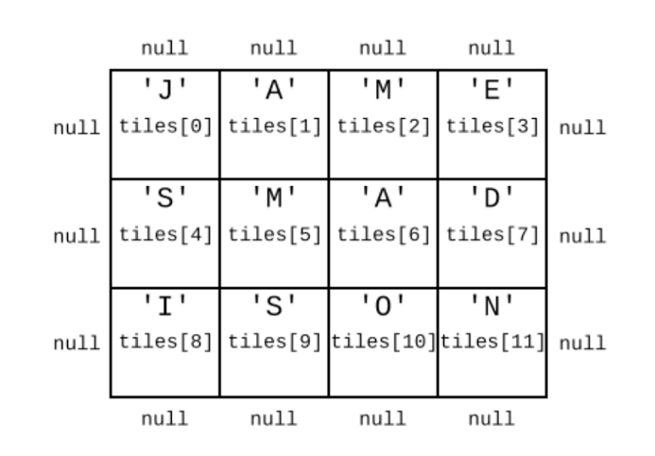
You could then test the addTile() method in your Guess class as follows:
Guess guess;
int status;
guess = new Guess("MAD");
status = guess.addTile(tiles[5]);
// Check to make sure status is Guess.INCOMPLETE
status = guess.addTile(tiles[6]);
// Check to make sure status is Guess.INCOMPLETE
status = guess.addTile(tiles[7]);
// Check to make sure status is Guess.CORRECT
Of course, this is not a complete test suite. You should do the same kind of thing with:
• A Guess that is ultimately incorrect,
• An attempt to add a Tile that is already in the Guess,
• An attempt to add a Tile that is not a neighbor of the last tile that was added.
• A removal of a Tile,
• An addition of a Tile after a removal of a Tile,
• etc.
The example above should get you started.
9.3 Implementing the toIndex() Method in the CharacterTracker Class
The count array in the CharacterTracker class is a both a lookup array and an accumulator array. The easiest way to do the lookup (i.e., to create a correspondence between char values and indexes) is to use the ASCII value of the char. The upper-case letter A-Z have consecutive ASCII values, and the ASCII value of upper-case A is 65. In Java, you can convert a char to an int by typecasting it. For example, the following
fragment:
char c;
int i;
c = 'A';
i = (int)c;
will assign the value 65 to i.
10. Submission
The submission for this assignment is divided into two parts that should be completed in order.
Part A: Understanding the Problem: due Wed 12/2 11:00 pm
To complete Part A you should first carefully read the product description and specifications. Once you feel confident that you have a good grasp of the assignment, log into Canvas and complete Part A. YOU MUST ANSWER ALL QUESTIONS CORRECTLY (earn 100%) TO GET ANY CREDIT FOR PART A. You may take the quiz as many times as necessary but if you do not complete it on time, you will receive zero credit.
Part B: Java Implementation: due Fri 12/11 11:00 pm
-15% before Sat 12/12 11:00 pm
-30% before Sun 12/13 11:00 pm
Not accepted after Sun 12/13 11:00 pm
Part B is an Autolab submission. You must submit a project.zip file containing only the following files: CharacterTracker.java, Game.java, GameDescriptor.java, Guess.java, Tile.java, and WordTangle.java. Your .zip file must not contain any source files you created for testing purposes, any .class files, and/or any data files.
Note, since this is a difficult assignment, there is no limit on the number of Autolab submissions. However, that does not mean that you shouldn't try to test your code “locally” before submitting it.
11. Grading
Part A accounts for 10 points of your grade on this assignment and Part B accounts for 90 points. Part A will be graded by Canvas and part B will be graded by Autolab and the Professor.
11.1 Autolab Grading
Your code must compile (in Autolab, this will be indicated in the section on “Does your code compile?”), and all class names and method signatures comply with the specifications (in Autolab, this will be indicated in the section on “Do your class names, method signatures, etc. comply with the specifications?”) for you to receive any points on this assignment.
| Checkstyle |
10 points (No Partial Credit) |
|
Correctness of the GameDescriptor class |
8 points (Partial Credit Possible) |
|
Correctness of the Tile class |
12 points (Partial Credit Possible) |
|
Correctness of the Game class |
12 points (Partial Credit Possible) |
|
Correctness of the Guess class |
20 points (Partial Credit Possible) |
|
Correctness of the CharacterTracker class |
12 points(Partial Credit Possible) |
|
Correctness of the complete product |
16 points (Partial Credit Possible) |
Note that this point allocation is not based solely on the difficulty of the class or the effort estimate for that class. For example, completing the Guess class will probably require 16 times more effort than completing the GameDescriptor class but it is only allocated 2.5 times as many points. This is so that you have an opportunity to earn points on this assignment even if you are unable to fully complete the difficult tasks.
Note also that, though you can earn partial credit, your code will not compile on Autolab if you don't submit all of the classes (with all of the required methods). This is why you were provided with stubs of all of the classes.
11.2 Manual Grading
After the due date, the Professor will manually review your code. At this time, points may be deducted for inelegant code, inappropriate variable names, bad comments, etc.